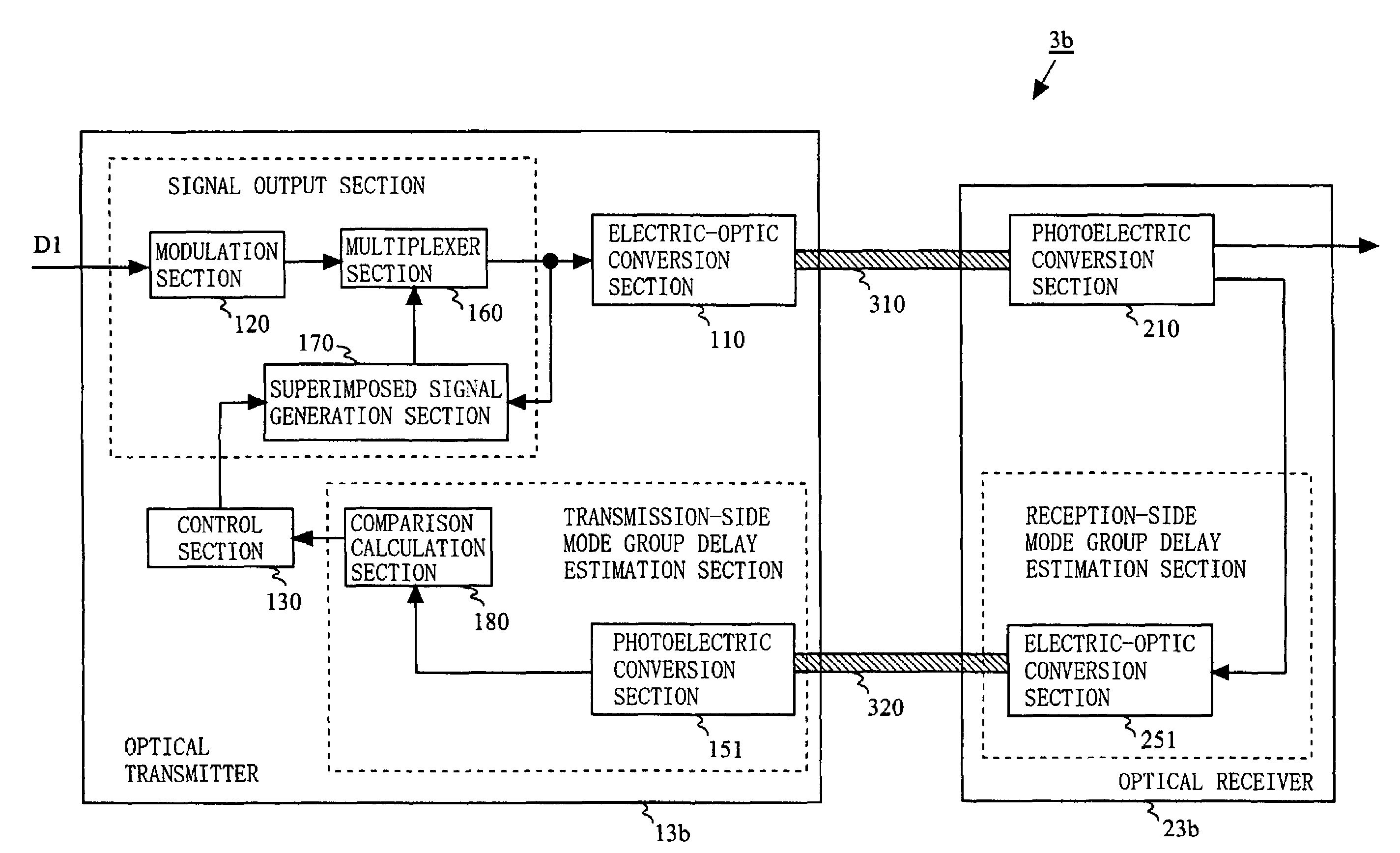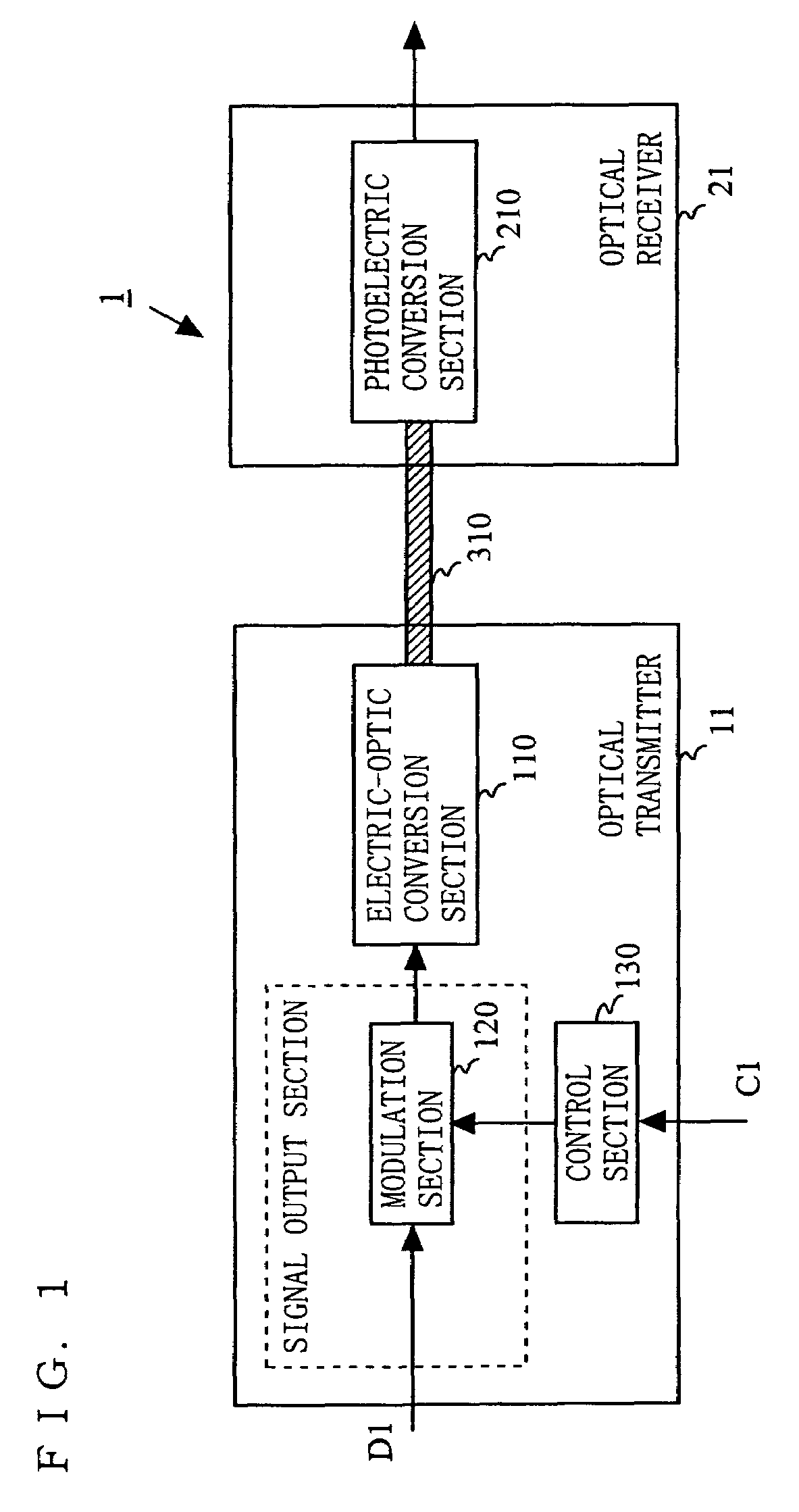Multimode optical transmission apparatus and multimode optical transmission system
a transmission apparatus and optical transmission technology, applied in the direction of optical radiation measurement, instruments, photometry using electric radiation detectors, etc., can solve the problems of optical fiber, noise called a modal noise, and deterioration of transmission characteristics
- Summary
- Abstract
- Description
- Claims
- Application Information
AI Technical Summary
Benefits of technology
Problems solved by technology
Method used
Image
Examples
first embodiment
[0041]FIG. 1 is a block diagram illustrating an exemplary structure of a multimode optical transmission system 1 according to a first embodiment of the present invention. As shown in FIG. 1, the multimode optical transmission system 1 comprises an optical transmitter 11 and an optical receiver 21, which are connected to each other via a multimode optical transmission line 310. The optical transmitter 11 includes an electric-optic conversion section 110, a modulation section 120, and a control section 130. The optical receiver 21 includes a photoelectric conversion section 210.
[0042]As shown in FIG. 1, data D1 is inputted to the optical transmitter 11 as data to be transmitted. The modulation section 120 modulates the data D1 and outputs the modulated data as a high frequency modulated signal. The electric-optic conversion section 110 coverts, into an optical signal, the high frequency modulated signal outputted by the modulation section 120, and outputs the optical signal to the mul...
second embodiment
[0061]In the first embodiment, the method for determining the frequency of the high frequency modulated signal based on the group delay difference Δτ between the reference mode and the first-order mode is described. In a second embodiment, when a superimposed signal is frequency-multiplexed with the high frequency modulated signal, the frequency of the superimposed signal is set to an optimal value so as to reduce the deterioration of the noise characteristic and the distortion characteristic caused by the interference between the modes.
[0062]FIG. 5 is a block diagram illustrating an exemplary structure of a multimode optical transmission system 2 according to the second embodiment of the present invention. As shown in FIG. 5, the multimode optical transmission system 2 comprises an optical transmitter 12 and an optical receiver 22, which are connected to each other via a multimode optical transmission line 310. The optical transmitter 12 includes an electric-optic conversion sectio...
third embodiment
[0079]In order to reduce the deterioration of the noise characteristic and the distortion characteristic caused by the interference between the modes, a method for appropriately setting the frequency of the high frequency modulated signal is used in the first embodiment and a method for appropriately setting the frequency of the superimposed signal which is frequency-multiplexed with the high frequency modulated signal is used in the second embodiment. In a third embodiment, described is a method for calculating the group delay difference Δτ between the reference mode and the first-order mode each propagating in the multimode optical transmission line 310 by utilizing the fact that the change in frequency of the high frequency modulated signal or change in frequency of superimposed signal changes an amount of distortion or an amount of noise.
[0080]FIG. 7A is a block diagram illustrating an exemplary structure of a multimode optical transmission system 3a according to the third embod...
PUM
 Login to View More
Login to View More Abstract
Description
Claims
Application Information
 Login to View More
Login to View More - R&D
- Intellectual Property
- Life Sciences
- Materials
- Tech Scout
- Unparalleled Data Quality
- Higher Quality Content
- 60% Fewer Hallucinations
Browse by: Latest US Patents, China's latest patents, Technical Efficacy Thesaurus, Application Domain, Technology Topic, Popular Technical Reports.
© 2025 PatSnap. All rights reserved.Legal|Privacy policy|Modern Slavery Act Transparency Statement|Sitemap|About US| Contact US: help@patsnap.com



